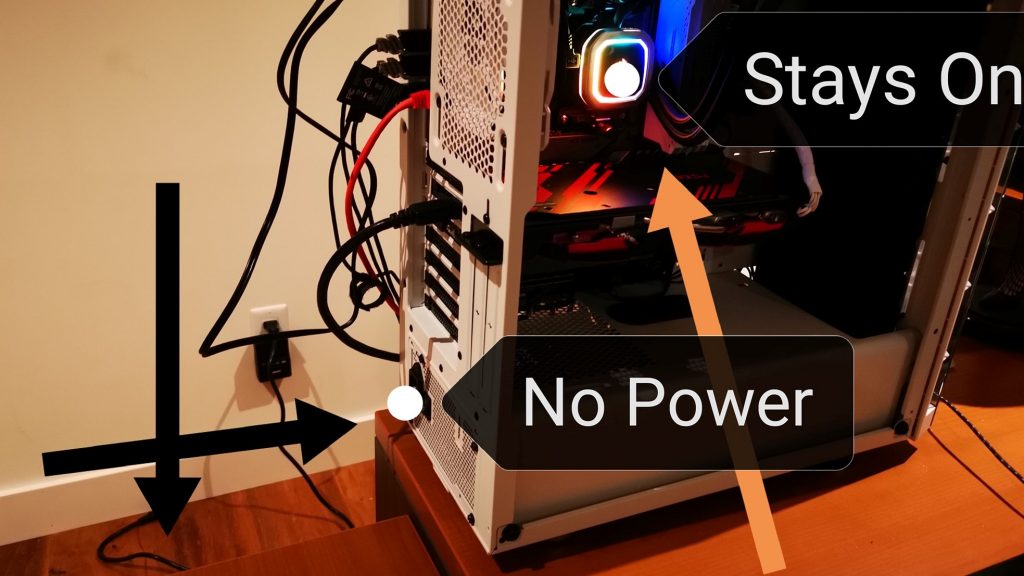One of my favorite pastimes is building computers. It can be frustrating at times. And yes, I don’t remember a single build taking less than a weekend to find tune things. My wife will tell you that the world stops when I start the build. If something goes wrong, good luck pulling me away…and 2am? I get my second wind right about then. If I am being completely honest… I thought I had a ‘ghost in the machine’ with this one.
For some reason, I would get Debug code ’00’ only when the system was shut off and the CPU cooler RGB would not shut off…even with the bios configured as it should be. In fact, unplugged for over a week, the Corsair H115i Platinum CPU cooler LED was still on…. If you can tell me where that CPU was getting its power, by all means comment below. At the end of the day, it was a simple Display Port cable change to fix both issues and that makes even less sense than the fact that the RGB just didn’t want to shut off.
NOTE: This issue was not the fault of the motherboard whatsoever, but rather, that of the DP cable. This is actually the most complete motherboard we have had in our hands to date.
And mess… Well the new office simply let’s me spread things out a bit more. Don’t think for a second that I don’t spend hours digging through this ‘pile’ looking for my screwdriver, or a specific screw or my flashlight… Our build today is the ASRock X570 Creator with AMD Ryzen 3700x, which brings us into the PCIe 4.0 world where we will see data transfer speeds now exceeding 5GB/s. Let’s get started…
Links… This Test Bench is only possible through the generous sponsorship of Corsair, ASRock, Kingston and Intel. If you click on the title of each component, it will bring you to that item in their website. Conversely, a bit lower you will find links that lead you to Amazon, if only for a price check.
CORSAIR iCUE 465X RGB MID-TOWER ATX SMART CASE
The Corsair iCue 465x comes in white and black and has tempered glass on the front and side. The system includes three LL120 RGB fans which are connected to an included Icue Lighting Node which allows for up to six RGB fans. The chassis is steel and I particularly like how we are now making a separate compartment for the PSU and storage which cleans up the interior quite a bit.
This picture shows how well organized things look, but I am also going to use it to describe my first concern. Corsair, included a Hydro H115i Platinum CPU cooler with this case and, as you can see, it didn’t fit in the top. That 280mm radiator would have stretched under the lid completely, hitting the motherboard. Not good. I originally settled with the Corsair Hydro H60 Liquid Cooler I had in the office, but as you will see later, I gave in as I didn’t want that Hydro H115i Platnum going to waste. I found a way.
The Corsair iCue 465x is available at Amazon for $149, which is a great price as the three LL120 RGB fans alone are priced at over $100.
 The SSD Review The Worlds Dedicated SSD Education and Review Resource |
The SSD Review The Worlds Dedicated SSD Education and Review Resource | 


Its v odd you dont compare the nvme’s results when connected to the chipset nvme port?
Perhaps you could elaborate?
It seems inevitable that chipset lanes are degraded vs native lanes, but by how much? Comparinga pcie 4 nvme on each type of nvme port seems a good test, & pertinent to many nvme buyers.
Peter is saying that the two NVMe ports are powered by different “grades” of PCIe lanes. One port is powered by native PCIe 4.0 lanes from the CPU, The other is powered by PCIe 4.0 lanes coming from the chipset.
The Ryzen 3 series has 24 lanes of PCIe 4.0 connectivity. (Check Anandtech article here: https://www.anandtech.com/show/14161/the-amd-x570-motherboard-overview). The breakdown is 16x for graphics, 4x for NVMe, 4x for the Chipset link.
The chipset offers an additional 24 lanes of PCIe 4.0. But all of those are bottlenecked by that 4x link between chipset and CPU.
So one of those NVMe ports is “native” to the CPU and will run full tilt. The other is sharing bandwidth with all of the USB ports, the TB3 ports, the wired network controller, the wireless/BT controller.
Hardware which are used in these devices are too good and reliable and the proficiency is beyond the mark.
Just bout one of these. Like you I was attracted to the TB3 ports. My Windows based laptop with TB3 needed me to turn it on in the bios for it to work. Did you have to do anything special to make TB3 run at full speed? Did you get a chance to experiment with routing video into one of the a DisplayPort input ports? If so how did that go. Does it work as full TB3 with a video signal included?